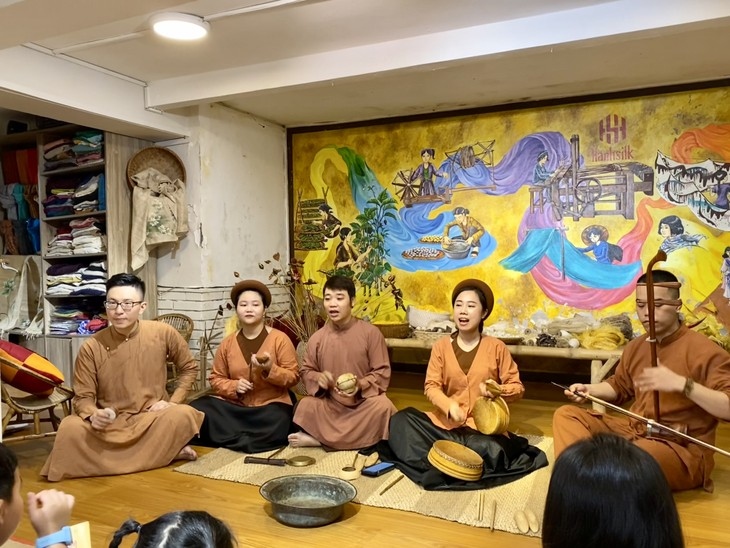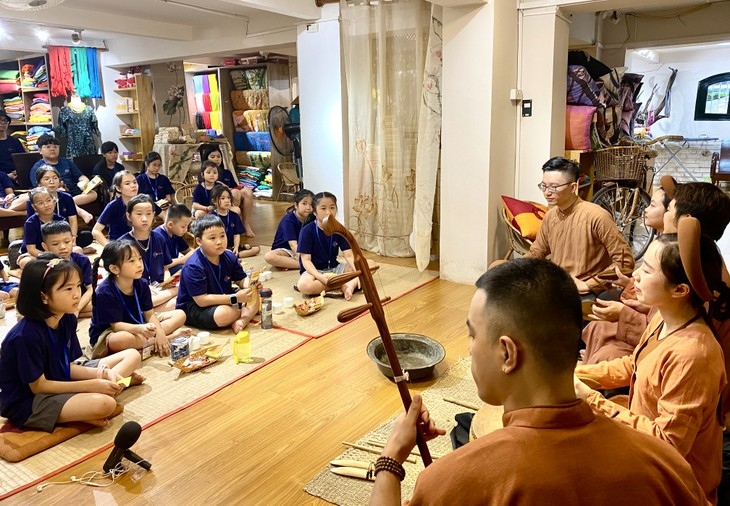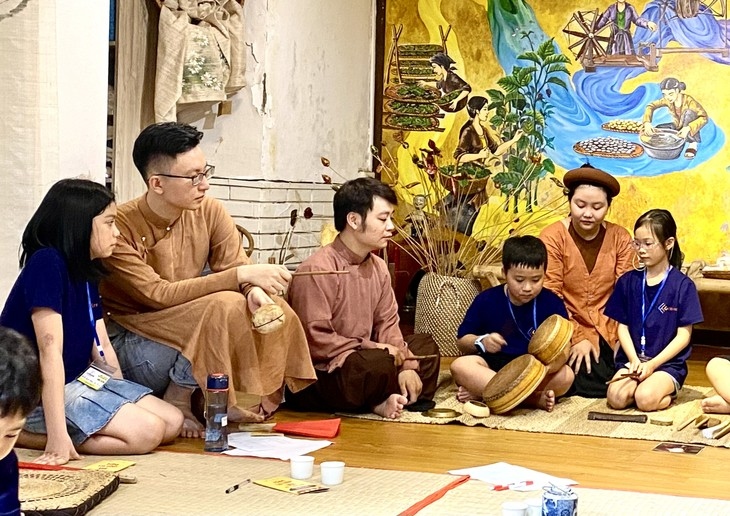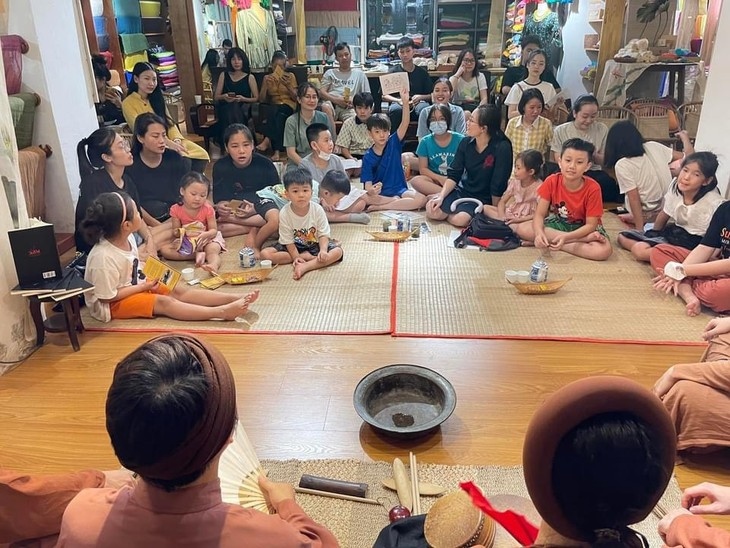Xam shows rekindle nostalgia, strengthen family bonds
VOV.VN - This summer the Centre for the Promotion of Vietnam’s Intangible Cultural Heritages is organizing “Xam for families” sessions, which are customized to suit groups of families, children, and adults.

“Xam” singing is a traditional art form which originated in Vietnam’s northern region hundreds of years ago.
Little children, who know nothing about xam and adults with knowhow and memories of xam, will have enjoyable moments to listen to and sing xam, play games with xam songs, play musical instrument like drum, castanets, Nhị two-string fiddle, and share their memories and emotions with others.
“Xam for families” is part of the Center’s long-term program “Xam in the city” to popularize the folk art genre.
Every Sunday morning, the Centre for the Promotion of Vietnam’s Intangible Cultural Heritages welcomes a group of about 30 people, who are family members, club members, or individuals to a xam show organized at the Vietnam Culture and Arts Exhibition Centre. They came to the show with different purposes.
Trung, who is working in marketing said, “I watched pieces of xam shows on TikTok which are very interesting. I also listened to some xam songs before. I expect to know more about xam from this show, such as xam melodies and performance.”

Minh Anh, who works in educational experience for children, shared, “I studied communications and education and are participating in some projects to promote Vietnam’s traditional culture and folk singing genres. I come here to learn more about xam.”
“Xam for families” welcomes a lot of children. Some children of FFC Training and Arts Centre, said, “I know nothing about xam. I come here to learn what xam is.”
“This is the first time I listen to xam. I’m excited to attend the show. I don’t know much about Vietnam’s folk music,” said a little girl.
We take a seat at the performing chamber, where singers take the audience on a time tram to return to Hanoi in the early of the 20th century. The performing space is small enough for the artists to sing without microphones and interact with the audience as close as possible.
Deputy Director of Centre for the Promotion of Vietnam’s Intangible Cultural Heritages and a xam artist, Dinh Thao introduces the journey. Every passenger is given a tram ticket and some coins before getting on the imaginary tram to travel on three tramways in Hanoi in the early 20th century.
Departing from the Cocotiers terminus, now the Dong Kinh Nghia Thuc square by Hoan Kiem Lake, Line 1 led southward to Mo market, Line 2 northeast ward to a village near the today’s Bưởi market, and Line 3, which ran west to the Temple of Literature and then headed southwest to Ap Thai Ha. In 1991, the tram in Hanoi completely stopped operation.
Xam song “Hanoi is like a fairy land” tells that Dong Xuan market in downtown Hanoi is the most exciting place. It attracts people from all walks of life coming to buy and sell every thing.
Nguyen Hoang Hiep, a xam artist who undertakes the content of Xam program, said, “We bring the concept “tram” to the show to tell the children about old Hanoi, what it had, what changed, and what disappeared. For older people they will have a chance to look back at their youth in the 1970s and 1980s, when people mainly rode bicycles and went on tram. We are confident to infuse xam to people of different ages.”
Mai Duc Thien, a xam artist and advisor of “Xam in the city”, said, “Xam in the city’ combines singing, telling stories, and playing musical instrument to interact with the audience. They engage in the show and have their own experience. We bring folk arts and contents to approach the audience of different ages in multiple forms with the breath of life."

Xam singing originated in Vietnam’s northern region about 700 years ago and used to be performed by visually-impaired and blind people to earn a living. They preferred busy and crowded places to perform so Xam styles are also differentiated by the performance space, such as Xam market (Xam cho), Xam chamber (Xam nha tro), and Xam tram (Xam tau dien), a unique Xam type in Hanoi.
Xam tram refers to those singing on tram. They calculated the time to finish singing one song between stations so the passengers could enjoy the whole song. Many of them sang to advertise what they sold such as balm, bamboo toothpicks, cough herbal medicine, and bulbs of kerosene lamps.
After singing a xam selling balm, Thien and Thao guide the children to play the crack-the-word game and learn some old words and concepts which are no longer used now. “Dau cu la” is an old word for “dau gio” or balm. The children can smell balm and see photos of xam people selling balm.
“For children, we aim to infuse and sow the seeds of xam art so that later in their life, or when they go to school or any place, if they listen to xam again, they will know it is xam. For adults, we recall their memories and evoke their nostalgia. If they go with families, we have activities to connect people of different generations, let them share their emotions and memories, and bring the old and the young closer,” said Thien.

At adults’ shows, the audience can ask the artists to sing the songs they want. The discussion is more informative and nostalgic when the artists and the audience get in touch with their emotions.
Artist Hiep added, “Xam in the city’ and ‘Xam for families’ create a social and joyful atmosphere for people to experience xam with a youthful and modern spirit. Our xam shows are organized inside HanhSilk showroom, which has a modern and traditional ambience. It may be different from some people’s memories of xam in the past. Old xam didn’t have stage because the visually impaired xam singers performed on the pavements or trams. Our message is xam has adapted to the temporary life.”
A xam song tells about parent’s merit to give birth and bring up the children. The mother bears a child for 9 months and 10 days; gives all the best she can to her child; and takes all the disadvantages to her side.
Le Minh Thang attended a xam show and shared with other people his memory of the first time he listened to xam when he was about 12 years old. After nearly five decades, the memory is still vivid in his mind.
“I’m very moved. You have recalled beautiful memories of my childhood. Xam lyrics and music have touched my inner feeling. I feel thankful to my parents, who often took me to our home village in Thai Binh province. I had many chances to listen to xam singing at the Hanoi railway station and Tan De wharf,” said Thang.
Hoang Hiep talked about the Centre for the Promotion of Vietnam’s Intangible Cultural Heritages’ guidelines for xam programs: “We don’t mix the traditional folk music and contemporary music. We focus on interaction and experience so the audience feel closer to old xam style. The artists wear clothes similarly to that in photos taken by the French in the early 20th century. We have collected and brought here old musical instruments. The Center has tried to balance between research, creative concepts, and practice.”
In the past the visually impaired Xam singers were always on the move. Although they couldn’t see, they had broad understanding of society and life which they brought to their songs.
There are famous songs about parents’ merits to give birth and raise the children, the condition of women in the old society, and family and social relationships. During the revolution, many of them worked as messengers as they could hide secrete documents on the musical instruments and travel as blind singers.
The Centre’s Deputy Director Dinh Thao said that young xam artists are keeping the traditional singing genre alive. "There are many xam groups and clubs. When there are major events or movements in society, they compose the lyrics or rewrite poems for singing. We sing about the COVID-19 pandemic, preventing excessive use of alcohol, and traffic safety.”
In about two hours the audience live in a full ambience of traditional music. The artists’ performance touches their souls.
“I feel thankful to the artists. We are the young generation, we don’t know much about the old time of our grandparents. This xam session is valuable and informative,” Loan, an attender, said.
A little boy shared his feeling: “When I come home, I will tell other people that xam show is interesting and joyful. I will tell my parents that we should come here again.”

The active engagement in all activities and share their feelings is the best encouragement for the artists. Parents and children to the “Xam for families” sing together “the father’s merit is as profound as Thai Son Mountain. The mother’s merit is like endless source of water. It’s the filial duty of children to respect and attend to their aged parents.
The Center for the Promotion of Vietnam’s Intangible Cultural Heritages has a fixed schedule for xam every Sunday morning. They will organize a show at any time in the week with customized content to suit both Vietnamese and foreign audience.
Besides xam, the Center also organizes performances of Quan Ho, Cheo, and other folk art genres at No2 Hoa Lu street, Hanoi or at a temple to create an ancient and nostalgic ambience. You can find them on Facebook and Tiktok to see the time table, contact, and related information.
